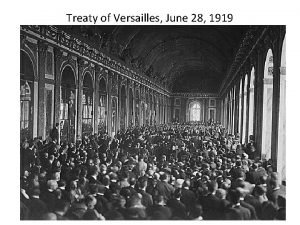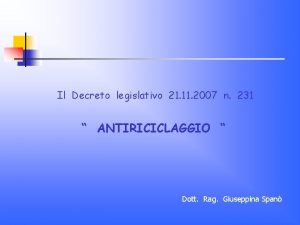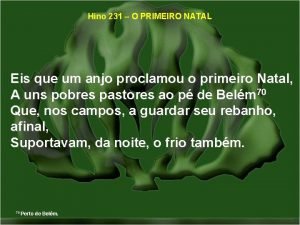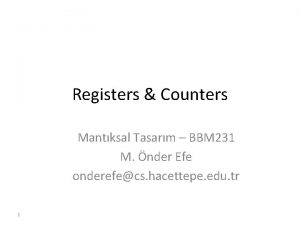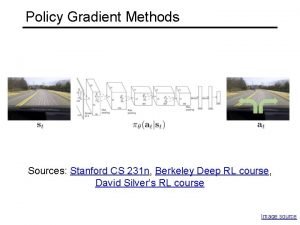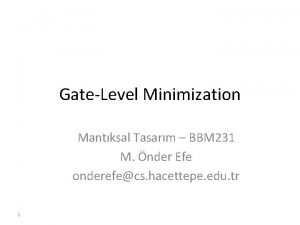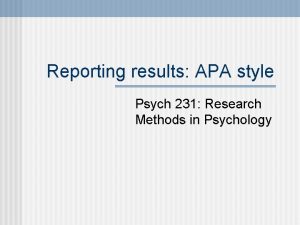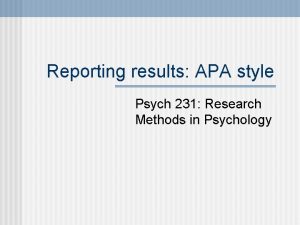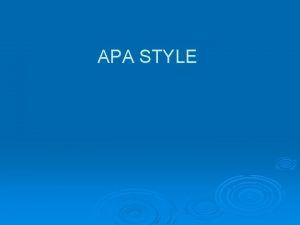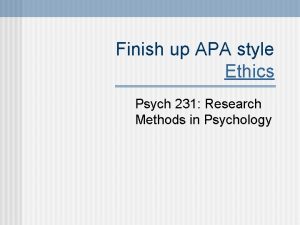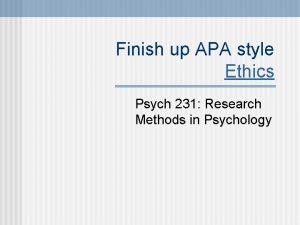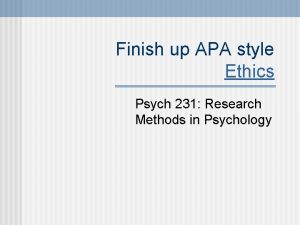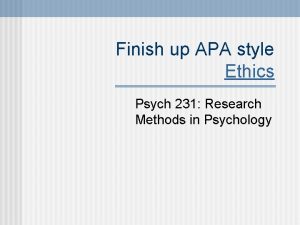Reporting results APA style Psych 231 Research Methods


















- Slides: 18

Reporting results: APA style Psych 231: Research Methods in Psychology

Why present your research? n Purpose of presenting your research – – To get the work out there to spur further research allow replication allow testing/falsifaction of your theory

Why a structured format? n To ease communication of what was done – forces a minimal amount of information – people know what to expect – where to find the information in the article

n The ultimate resource for APA style is the APA Publication manual, but also lots of websites to help too. n Appendix A of your textbook is good too.

Major goal: Clarity Remember that the goal of your research is to communicate what you did, so you want to be as clear as you can. n Avoid jargon when possible, don’t be too creative, avoid slang and colloquialisms. n Avoid sexist and biased language n Also try to be fairly concise – don’t use a whole paragraph when two sentences will do n

Writing style n Psychological writing tends to differ from other academic writings • Try to avoid using direct quotes, restate things in your own words. • Footnotes are rare, they’re used to elaborate/clarify a point. Try to do so in the text.

Parts of a research report n n n n n Title Page Abstract Body References Authors Notes Footnotes Tables Figure Captions Figures

Title Page n Title, Authors, Affiliation, Short title, running head – Title should be maximally informative while short (10 to 12 words recommended) – Order of Authorship sometimes carries meaning – Affiliation – where the bulk of the research was done – Running head – will go on each page of published article, no more than 50 characters – Short title – goes in header (with page number) on each page of the manuscript

Abstract n short summary of entire paper – – – 100 to 120 words the problem/issue the method the results the major conclusions

Body Hourglass shape n Introduction n – – Background Literature Review Statement of purpose Specific hypotheses (at least at operational level)

Body n Methods (in enough detail that the reader can replicate the study) – Participants • How many, where they were selected from, any special selection requirements, details about those who didn’t complete the experiment – Design (optional) – suggested if you have a complex experimental design, often combined with Materials section – Apparatus/Materials – Procedure – what did each participant do? Other details, including the operational levels of your IV(s) and DV(s), counterbalancing, etc.

Body n Results (state the results but don’t interpret them here) – Verbal statement of results – Tables and figures – these get referred to in the text, but actually get put into their own sections at the end of the manuscript – Statistical Outcomes

Body n Discussion (interpret the results) – – Relationship between purpose and results Theoretical (or methodological) contribution Implications Future directions (optional)

The rest n n n References Authors Notes Footnotes Tables Figure Captions Figures

Figures and tables These are used to supplement the text. n To make a point clearer for the reader. n Typically used for: n – The design – Examples of stimuli – Patterns of results

Checklist - things to watch for Clarity n Acknowledge the work of others (avoid plagiarism) n Active vs. passive voice n – Active: Coane and Kearney (2003) hypothesized that speakers use to much passive voice – Passive: It was hypothesized by Coane and Kearney (2003) that speakers use to much passive voice

Checklist - things to watch for n Avoid biased language – APA guidelines: • Accurate descriptions of individuals (e. g. , Asian vs. Korean) • Be sensitive to labels (e. g. , “Oriental”) Appropriate use of headings n Correct citing and references n Good grammar n

Next time Read chapters 4&5. n Bring your APA Publication Manual to lab (if you’ve got one) n Don’t forget your first journal summary is due this week in lab n
 Reporting beat
Reporting beat Abstract background methods results conclusion
Abstract background methods results conclusion Introduction method result and discussion
Introduction method result and discussion Direct and indirect wax pattern
Direct and indirect wax pattern Acf 231
Acf 231 Article 231 of the treaty of versailles
Article 231 of the treaty of versailles 123 132 213 231 312 321
123 132 213 231 312 321 Phy 231 msu
Phy 231 msu Dlgs 231/2007
Dlgs 231/2007 Ah um anjo proclamou o primeiro natal
Ah um anjo proclamou o primeiro natal Gezang 231
Gezang 231 Counters
Counters Transitor
Transitor Cost 231 model
Cost 231 model Draw 231 with base ten blocks
Draw 231 with base ten blocks 040 231 3666
040 231 3666 Mvcnn pytorch
Mvcnn pytorch Stanford 231n
Stanford 231n Bbm 231
Bbm 231





